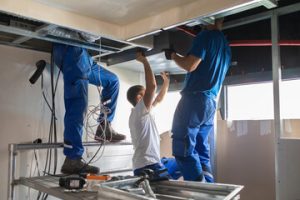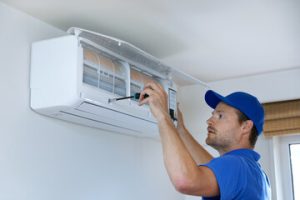Air conditioning is a vital component of modern comfort, keeping homes, offices, and commercial spaces cool during hot months. When an air conditioning system fails or underperforms, it can lead to discomfort, reduced productivity, and in some cases, health concerns. Fast and reliable Air Conditioning Repair Round Rock TX is essential to restore proper cooling, maintain energy efficiency, and ensure a comfortable indoor environment. Professional repair services address issues quickly and effectively, preventing minor problems from escalating into costly replacements or long-term damage.
The Importance of Timely Air Conditioning Repair

Air conditioning systems are complex assemblies of mechanical, electrical, and refrigerant components. These include compressors, evaporator and condenser coils, fans, ductwork, thermostats, and filters. When any of these components fail or become inefficient, the system may struggle to cool the space properly, increase energy usage, and even pose safety risks.
Timely AC repair is critical because it restores proper cooling, maintains comfort, and prevents damage to the system. Professional repair services offer accurate diagnostics, expert solutions, and high-quality parts to ensure the system operates reliably. Delaying repairs can lead to more severe problems, including total system failure, higher repair costs, and discomfort during peak heat periods.
For homeowners, fast and reliable repair ensures that living spaces remain cool and comfortable. For businesses, it supports productivity, maintains equipment safety, and creates a comfortable environment for employees and customers.
Common Air Conditioning Problems
Understanding common AC problems helps property owners recognize when repair services are needed. Skilled technicians address a wide range of issues, including:
- Insufficient Cooling
- When a system fails to cool effectively, it may be due to low refrigerant levels, dirty coils, clogged filters, or compressor issues. Technicians assess airflow, inspect refrigerant levels, and repair or replace faulty components to restore efficient cooling.
- Leaking Refrigerant
- Air conditioners rely on refrigerant to transfer heat and maintain proper cooling. Leaks reduce efficiency, strain the compressor, and can lead to system failure. Professional repair services locate and fix leaks, recharge refrigerant, and test the system for optimal performance.
- Frozen Evaporator Coils
- Ice buildup on evaporator coils indicates airflow problems, low refrigerant, or dirty coils. Technicians resolve these issues by cleaning components, correcting airflow, and recharging refrigerant if necessary.
- Faulty Electrical Components
- Blown fuses, malfunctioning capacitors, or faulty wiring can cause AC units to stop working or operate inconsistently. Experts safely repair or replace electrical parts to restore reliable operation.
- Unusual Noises or Vibrations
- Rattling, grinding, or buzzing noises often signal mechanical or electrical issues. Repair technicians identify the source, whether it’s a loose fan, worn motor, or failing compressor, and perform the necessary repairs.
- Water Leaks
- AC systems produce condensation during operation. Leaks from drainage lines or pans indicate blockages or drainage problems. Professionals clear the blockage, repair damaged components, and prevent further water damage.
- Thermostat Issues
- A malfunctioning thermostat can cause inconsistent temperatures, short cycling, or system failure. Repair specialists recalibrate, repair, or replace thermostats to ensure accurate temperature control.
Addressing these issues promptly restores cooling performance, enhances energy efficiency, and prevents further system damage.
Benefits of Fast and Reliable AC Repair
Professional air conditioning repair offers several advantages for both residential and commercial properties:
- Restored Comfort: Quick repairs ensure indoor spaces remain cool and comfortable during hot weather.
- Energy Efficiency: A properly functioning AC unit uses less energy, reducing utility costs and environmental impact.
- Extended System Lifespan: Timely repairs prevent minor issues from escalating, prolonging the life of the system.
- Improved Air Quality: Clean components and proper refrigerant levels contribute to healthier indoor air by reducing dust, allergens, and humidity problems.
- Cost Savings: Addressing problems early prevents major breakdowns and reduces the need for expensive replacements.
- Reliability: Fast, professional repair ensures that the system operates consistently, avoiding unexpected downtime.
Investing in expert AC repair guarantees that cooling performance is restored efficiently and reliably.
The Role of Skilled Technicians
Expert technicians play a critical role in providing fast and reliable air conditioning repair. Their training, tools, and experience enable them to:
- Diagnose Issues Accurately: Advanced diagnostic tools allow technicians to identify the root cause of cooling problems quickly.
- Perform Safe Repairs: Handling refrigerants, electrical components, and mechanical systems requires specialized skills and adherence to safety standards.
- Use High-Quality Parts: Replacing worn or faulty components with quality parts ensures reliable performance and durability.
- Provide Maintenance Advice: Technicians often offer recommendations to prevent future problems, enhancing system longevity and efficiency.
By relying on skilled professionals, property owners can ensure that their AC systems receive precise, safe, and long-lasting repairs.
Preventive Maintenance to Reduce AC Repairs
Regular maintenance is the key to minimizing emergency repairs and keeping air conditioning systems running efficiently. Preventive maintenance tasks include:
- Filter Cleaning or Replacement: Clean filters maintain airflow, improve energy efficiency, and enhance indoor air quality.
- Coil Cleaning: Dirt and debris on evaporator and condenser coils reduce heat transfer efficiency. Regular cleaning ensures optimal cooling performance.
- Refrigerant Checks: Maintaining proper refrigerant levels prevents compressor strain and supports efficient operation.
- Electrical Inspections: Checking wiring, fuses, and capacitors prevents electrical failures and ensures safe operation.
- Drain Line Cleaning: Clearing blockages in condensation lines prevents leaks and water damage.
- System Testing: Inspecting overall system performance and airflow helps identify potential issues before they require repair.
Many AC service providers offer seasonal maintenance plans that schedule inspections before summer, ensuring systems are ready for peak cooling demand. Preventive maintenance reduces repair costs, enhances energy efficiency, and maintains year-round comfort.
Energy Efficiency and Cost Savings
Fast and reliable AC repair contributes directly to energy efficiency. When systems operate correctly, they consume less electricity while providing consistent cooling. Efficiency improvements include:
- Repairing Refrigerant Leaks: Proper refrigerant levels optimize cooling and reduce energy waste.
- Restoring Proper Airflow: Clearing blocked vents and cleaning components prevents the system from overworking.
- Upgrading Components: Replacing worn motors, fans, or compressors improves system efficiency.
- Thermostat Optimization: Correct calibration and programmable settings reduce unnecessary energy use.
Improved energy efficiency lowers utility bills and helps reduce the environmental footprint of homes and businesses.
Residential vs. Commercial AC Repair
Residential AC Repair:
Homeowners benefit from fast and reliable repair through restored comfort, improved indoor air quality, and energy savings. Quick service is particularly important during extreme heat to maintain a safe and comfortable living environment.
Commercial AC Repair:
Businesses rely on functional AC systems to ensure employee productivity, protect equipment, and provide a comfortable environment for customers. Prompt repair minimizes downtime, supports operational efficiency, and maintains a safe working space.
Both residential and commercial properties gain significant advantages from professional AC repair services that are fast, reliable, and effective.
Signs You Need Air Conditioning Repair
Property owners should look for warning signs that indicate the need for professional AC repair, including:
- Reduced or uneven cooling throughout the property
- Strange noises or vibrations from the system
- Water leaks or excessive condensation
- Ice formation on evaporator coils
- Frequent system cycling or short cycling
- Rising energy bills despite normal use
- Poor indoor air quality or unusual odors
Early detection and professional repair prevent minor issues from escalating and ensure continuous cooling performance.
Choosing a Reliable AC Repair Service
Selecting the right service provider is essential for fast and effective repairs. Key considerations include:
- Experience and Expertise: Technicians should know about various AC systems and brands.
- Comprehensive Services: Providers should offer repair, maintenance, and installation options.
- Quick Response Time: Fast service is critical, especially during peak heat periods.
- Quality Parts and Equipment: Using durable, high-quality replacement components ensures long-term reliability.
- Maintenance Plans: Providers offering preventive maintenance help minimize future repairs and maintain system efficiency.
A trusted AC repair service ensures consistent cooling, improved energy efficiency, and peace of mind for both homeowners and businesses.
Fast and reliable air conditioning repair is essential for maintaining indoor comfort, energy efficiency, and system longevity. Expert technicians provide professional diagnostics, repairs, and maintenance to restore proper cooling, prevent future breakdowns, and optimize system performance.
Routine preventive maintenance minimizes repair needs, improves energy efficiency, and maintains indoor air quality. Timely repair of common issues such as refrigerant leaks, electrical failures, frozen coils, or airflow problems ensures that AC systems operate efficiently and reliably.
Whether for residential or commercial properties, investing in fast and reliable AC repair ensures consistent cooling, enhanced comfort, and reduced energy costs. Professional AC services are not just a convenience—they are a critical investment in health, comfort, and long-term system performance.

